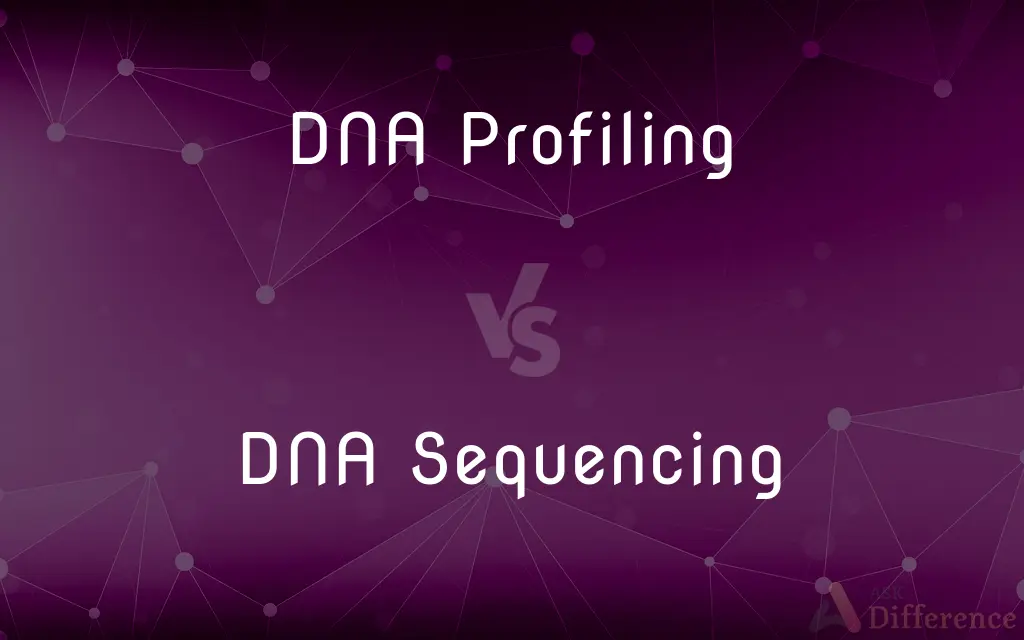DNA Profiling vs. DNA Sequencing — What's the Difference?
By Tayyaba Rehman — Published on January 14, 2024
DNA profiling identifies unique genetic patterns for individual identification, while DNA sequencing determines the precise order of nucleotides within a DNA molecule.

Difference Between DNA Profiling and DNA Sequencing
Table of Contents
ADVERTISEMENT
Key Differences
DNA profiling, also known as genetic fingerprinting, is a technique used to identify individuals by analyzing specific regions of their DNA that are unique to each person. This method doesn't require sequencing the entire DNA but focuses on certain markers or loci that vary greatly among individuals. DNA sequencing, on the other hand, is the process of determining the exact sequence of nucleotides within a DNA molecule. It involves reading the order of the four bases: adenine, guanine, cytosine, and thymine.
DNA profiling is commonly used in forensic science for identifying individuals in criminal investigations and in paternity tests. The technique looks at specific DNA regions with high variability to distinguish one person from another. DNA sequencing has a broader range of applications, including research in genetics, evolutionary biology, and medical diagnostics. It provides a comprehensive picture of an organism's genetic makeup.
The technology and methods used in DNA profiling and sequencing are different. DNA profiling often uses methods like Short Tandem Repeat (STR) analysis or Restriction Fragment Length Polymorphism (RFLP). DNA sequencing methods include Sanger sequencing and Next Generation Sequencing (NGS), which can sequence entire genomes.
In terms of data output, DNA profiling results in a pattern of bands or a numerical profile that represents an individual's genetic makeup at specific loci. DNA sequencing results in a long string of nucleotide bases, providing detailed and comprehensive genetic information.
DNA profiling is more limited in scope, focusing on identification and comparison between individuals. DNA sequencing provides a wealth of genetic information that can be used to understand gene function, genetic variations, and mutations.
ADVERTISEMENT
Comparison Chart
Purpose
Identification of individuals
Determination of exact DNA sequence
Method
Analyzes specific variable regions
Reads the order of all nucleotides in DNA
Usage
Forensic science, paternity testing
Genetic research, evolutionary biology, medicine
Technology
STR analysis, RFLP
Sanger sequencing, Next Generation Sequencing (NGS)
Data Output
Unique genetic patterns or profiles
Comprehensive genetic sequence
Compare with Definitions
DNA Profiling
Individual differentiation
Each family member was distinguished using DNA profiling.
DNA Sequencing
Medical diagnostics
Genetic mutations were identified using DNA sequencing.
DNA Profiling
Forensic identification
DNA profiling was used to identify the suspect in the investigation.
DNA Sequencing
Determining nucleotide order
The gene was analyzed through DNA sequencing.
DNA Profiling
STR analysis
DNA profiling in the case was done using Short Tandem Repeat analysis.
DNA Sequencing
Genetic research
DNA sequencing helps in studying genetic diseases.
DNA Profiling
Paternity testing
Paternity was confirmed through DNA profiling.
DNA Sequencing
Evolutionary studies
DNA sequencing revealed the evolutionary history of the species.
DNA Profiling
Genetic fingerprinting
DNA profiling creates a unique genetic fingerprint for each individual.
DNA Sequencing
Genome mapping
The entire genome of the plant was decoded through DNA sequencing.
Common Curiosities
Can DNA sequencing detect genetic disorders?
Yes, it's instrumental in identifying genetic mutations.
Is DNA profiling used in ancestry testing?
Yes, it can be used to trace familial lineage.
Can DNA sequencing determine an organism's traits?
Yes, it provides insights into traits governed by genetics.
How accurate is DNA profiling in forensics?
Extremely accurate when done correctly.
Does DNA sequencing read the entire genome?
Whole-genome sequencing does, but some methods target specific regions.
Is DNA profiling the same as a DNA test?
DNA profiling is a type of DNA test focused on identification.
Can DNA profiling determine a person's health?
No, it's used for identification, not health analysis.
Can DNA profiling be wrong?
Errors can occur, but they are rare with proper procedures.
How long does DNA sequencing take?
It varies, but modern techniques can be relatively fast.
Is DNA profiling specific to humans?
No, it can be used for any species with variable DNA regions.
Are DNA profiling results instant?
No, it requires lab analysis and can take several days.
Can DNA sequencing be used for species identification?
Yes, it's a key tool in identifying and classifying species.
What's the future of DNA sequencing?
It's evolving towards faster, cheaper, and more accurate methods.
Is DNA sequencing used in cancer research?
Yes, particularly in understanding cancer genetics.
Does DNA profiling involve privacy concerns?
Yes, especially regarding the handling and storage of genetic data.
Share Your Discovery

Previous Comparison
Berries vs. Fruits
Next Comparison
DROP in SQL vs. TRUNCATE in SQLAuthor Spotlight
Written by
Tayyaba RehmanTayyaba Rehman is a distinguished writer, currently serving as a primary contributor to askdifference.com. As a researcher in semantics and etymology, Tayyaba's passion for the complexity of languages and their distinctions has found a perfect home on the platform. Tayyaba delves into the intricacies of language, distinguishing between commonly confused words and phrases, thereby providing clarity for readers worldwide.
















































